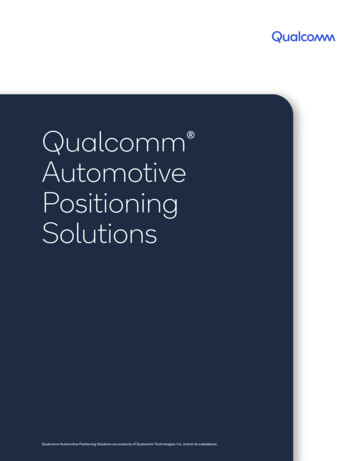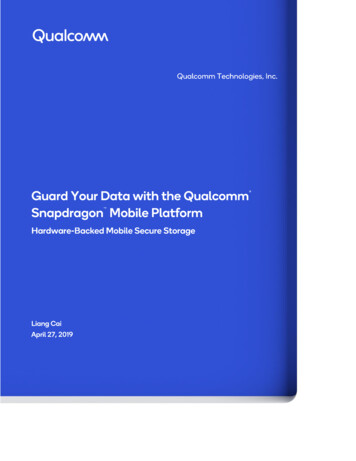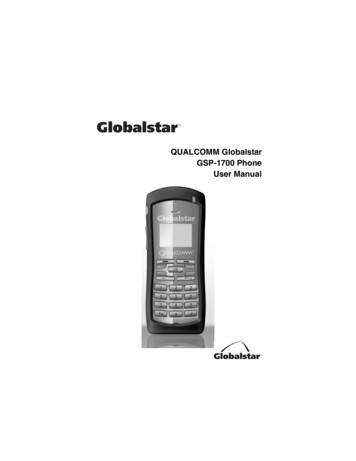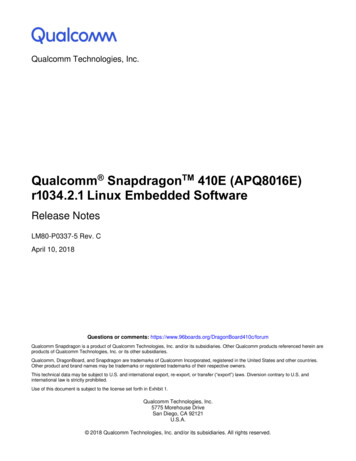
Transcription
May 2021@QCOMReseachPioneering5G BroadcastBuilding on multiple generations ofcellular broadcast technology leadership
Video continues to bethe major traffic driverof our networks 226B Gigabytes monthly global mobile datain 2026 — 665% growth expected since 2019Video traffic will account for 80% of overallmobile data traffic by 2022 800 million users engaged with live streamson Facebook and Instagram DailyGrowing consumption of live sports broadcast,e.g., 7.2M people watched the 2020 UEFAChampions League final on Facebook LiveEffective video livestream commerce, e.g.,Taobao generated 15B in sales throughlivestream in 2018)Source: Ericsson Mobility Report November 2020, Facebook from 5G Broadcast World 2021,Andreessen Horowitz 2019 /)2
Cellularbroadcastbrings benefitsto a widerange ofdeploymentsMore efficient deliveryof mass data and livemedia contentVideo streaming for live eventse.g., concerts, sportsLivestream commerce e.g.,broadcast phone shoppingPublic safetycommunicationInteractive content e.g., linkingto related channels / videosDigital TV broadcaste.g., linear TV deliveryAutomotive safetye.g., cellular V2XVirtually seamless mobileand fixed accessNew media formats, e.g.,extended Reality (XR)Group firmware updatefor IoT devicesPress “enter” to learn more Richer, more immersiveand personalizedviewer experienceExpanded use casesbeyond mobile suchas automotive3
Standalone broadcastMixed-mode multicastDedicated broadcasting network to provide a common deliveryplatform for richer contents and servicesLow-power network supporting dynamic mode switching betweenunicast and broadcast to more efficiently deliver identical contentAddressing broadcaster requirements for content deliveryAddressing mobile operator requirements for improved capacitySingle Frequency Network (SFN)for downlink broadcast onlyLive distribution of mass media contente.g., digital TV, live sports, and digital signageDynamic switching between broadcastand unicast, e.g., SC-PTM1Broader 5G use casese.g., efficient eMBB delivery, SW/FW update,IoT, V2X, and public safety5G defines two modes of broadcast communicationAddressing diverse ecosystem, deployment, and use case requirements1 Single-cell point-to-multipoint4
Digital TV delivery with5G broadcast is readyfor prime timeStandardization completedRelease 16 specifications of 5G broadcast can meetall key requirements for digital TV deliverySpectrum availableUHF band (i.e., 470 to 698 MHz) can be used for digital TV broadcastin Europe, China, and other regionsLow deployment costSystem is designed for high efficiency, quick time-to-market,and reuse of broadcasting HPHT1 infrastructureTailored for broadcastersSupport for receive-only mode, downlink-only,dedicated broadcast spectrum, and more5G Standalone Broadcast3GPP Release 16Service layer integrationBroadcaster apps, DVB-I2, DASH/HLS3, CMAF4, as well as unicastcan be deployed with/on top of 5G broadcastContinued enhancements5G broadcast technology continues to evolve in future releases,bringing better performance and efficiency1 High-power, high-tower; 2 Digital Video Broadcasting; 3 Dynamic Adaptive Streaming over HTTP and HTTP Live Streaming; 4 Common Media Application Format5
5G unlocks newopportunitiesand efficienciesfor the TVbroadcastingecosystem6
A new 5G system design can transformdigital TV broadcastingRicher content,new devices,and broaderaudience reach7
Generating new values for the mobile,broadcasting, and broader media ecosystemCreate newpartnershipopportunities formobile operators,broadcasters andcontent creators todrive innovationsAllowbroadcastersto reach broaderaudiences andprovide higherquality, newexperiencesEnable mobileoperators to delivervalue-addedservices using aflexible 5G networkthat can adapt tofuture needsProvide broaderaccess to thelarge, existingsmartphoneuser base andnew devices(e.g., cars, XR)8
Field video productionTV broadcast networkNew experiencesand devices (e.g.,live sports on XR)Wirelessly connected studioCellular networkNew services(e.g., livestreamcommerce)Buy NowContent ProductionContent DeliveryMedia Consumption5G brings innovation opportunities acrossthe TV broadcasting value chain9
Designing a scalable 5G system for high-quality content deliveryCombined with unicast service (e.g., eMBB) provided by 5G mobile operatorsDigital TV broadcasters(e.g., TV, paid TV, etc.)MediagatewayBroadcastCloud/5G core networkOTT1 content providers(e.g., streaming media, etc.)Addressingunmet needs(Examples) Efficient support for newand high-quality mediaformats such as 360ovideo and virtual reality Standardized interfacefor content injection Wide coverage, higherefficiency, capacity, mobility, Unified protocol stack forbroadcast and unicast Shared broadcast formultiple operators Deployment flexibility (e.g.,HPHT2 vs. cellular, fixed vs.mobile, broadcast only vs.dynamic mode switching) Reuse building blocks of existingcellular modem functionalities New and existing devices (e.g.,smartphones and receive-only TV)5G standalone broadcast a unified and standardized media delivery frameworkFor broadcasters, content providers, mobile operators, service providers, device manufacturers1 Over-the-top; 2 High-power, high-tower10
5G has a richevolutionroadmap forbroadcasttechnologiesNew services, devices, deployments11
1.6.Existing broadcast services(e.g., download, streaming,group comm., TV) andnew services (e.g., V2X)Broadcast network sharingbetween multiple participatingoperators, including dedicatedbroadcast network7.2.Dynamic adjustments ofbroadcast area based one.g., the user distributionor service requirements3.Concurrent delivery ofboth unicast and broadcastservices to users4.Efficient multiplexing withunicast transmissionsin at least frequencyand time domain5.Static and dynamic resourceallocation between broadcast(up to 100%) and unicast5G Broadcast mustsupport 3GPP defined 5Gbroadcast requirementsPart of 5G NR Rel-14 Study Item — TR 38.913Cover large local, regional,national broadcast areas(e.g., entire country) of up to100 km cell radius in SFN modewith network synchronization8.Broadcast for fixed,portable and mobile devices,with speeds up to 250 km/h9.Leverage usage of accessnetwork equipment includinge.g., MIMO to improve broadcastcapacity and reliability10.Broadcast services for massive IoTdevices (e.g., for OTA firmware update)12
The foundation for 5G broadcast spans across generationsNew enhanced TV (enTV) systemdesigned to efficiently supportterrestrial digital TV broadcast,eMBMS2 defined for LTE,improving coverage andsystem Rel-16 )Cellular broadcast (MBMS1) firstsupported in EDGE, CDMA20001xEV-DO and WCDMAeMBMS supports modeswitching (MooD3) andexpands to MCPTT4Meets all 5G Broadcast requirements,enabling standalone broadcast andexpanding to new servicesCellular Broadcast EvolutionFocused on the needs of mobile operatorsExpansion addressing the needs of broadcasters,content providers, and more Building on the learnings from multiple generationsof cellular broadcast1 Multimedia Broadcast Multicast Service; 2 Enhanced MBMS; 3 MBMS operation on demand; 4 Mission-critical push to talk13
Evolving LTE broadcast — the early 3GPP releasesRadio accessfeaturesBroadcast15 kHz numerologyMulti-cell transmission only in MBSFN4Transmission on downlinkdata channel7 with newgroup identitiesUp to 60% of subframesfor MBSFN transmissionNon-synchronizedtransmittersExtended CP3 of 16.7µsRel-8/91Rel-12Rel-13Video streamingInterface to non-3GPPgroup communicationapplication server(i.e., MCPTT6)Extending Rel-12 modelto other new servicessuch as LTE IoT andC-V2X8Integrated transport and serviceSystem layerfeaturesSingle-celltransmissionMixed unicast / MBMS2 carrierBM-SC5 for MBMS bearerestablishment, media formatting,and service announcementsStatic MBSFN areasSC-PTM 9 is transparentto the enhanced packetcore networkRel-14Enhanced TV(enTV)A new broadcastsystem design fordigital TV deliveryLTE Broadcast was defined to meet the needs of mobile operators1 3GPP Rel-8 defined physical layer aspects, Rel-9 defined higher layer and network related aspects; 2 Multimedia Broadcast Multicast Service; 3 Cyclic prefix; 4 Multicast broadcast single-frequency network; 5 Broadcast multicastservice center, part of EPC — enhanced packet core; 6 Mission-critical push to talk; 7 PDSCH — Physical Downlink Shared Channel; 8 Cellular Vehicle to Everything; 9 Single cell point to multipoint14
Redefining cellular broadcast for digital TV deliveryA new system design addressing the needs of broadcasters, content providers, Radio access enhancementsSystem layer enhancementsLonger rangeReceive only mode1-symbol numerology with longer200 µs CP1 to support 15 km ISD2Delivery of free-to-air content to deviceswithout SIM/service subscriptionMore broadcast capacityUnified protocol stackRel-14Enhanced TV(enTV)Supports dedicated broadcast networkwith 100% eMBMS carrier allocationMore deployment flexibilitySingle network for mobile and fixed deviceswith enhanced support for rooftop receptionBetter efficiencyNew subframe design reduces overheadin dedicated broadcast transmissionsUnicast controlBroadcastBroadcastTV broadcasters can deliver contentin native format3 without transcodingStandardized interface4Content providers can deliver mediaover 5G Broadcast with a unified frameworkContent providerxMBShared broadcastMultiple operators can serve userson a common broadcast carrier1 Cyclic Prefix; 2 Inter-site distance; 3 Such as CMAF: Common Media Application Format that is compatible with unicast and broadcast stacks; 4 Defined a set of standardized APIs15
enTV has evolved in Rel-16to become 5G broadcast1Wide ecosystemsupport in 3GPPFulfilling all 5G requirements defined for broadcastList of supporting individualmembers in RP-193050 (Rel-16)Rel-14 completed newbroadcast design thatmet many 5GrequirementsenTVevolutiontimelineRel-16 Study Item —a gap analysis —was completed inMarch 2019Industry/ecosystemactivities & minorenhancements inRel-17 and beyondAcademy of Broadcasting ScienceBittium WirelessCellnex Telecom20172018201920202021 BMWiCHTTLBBCBritish TelecomDishEuropean Broadcast UnionEuropean Space Agency5G broadcast included aspart of the Rel-16 projectpackage in RAN#78Rel-16 WorkItems completedin June 2020Rel-16 enTV supports more diversestandalone broadcast deploymentsTV broadcast infrastructure:MPMT2 & HPHT3 deploymentswith rooftop receptionHigher mobility: 250km/h with car-mountedLPLT4 deploymentENENSYS TechnologiesFraunhofer IISNomorSamsungFraunhofer HHINokiaOne2manyExpwayNokia Shanghai BellQualcommRohde & SchwarzShanghai Jiao Tung UniversityUniversity of the Basque Country1 Defined in TR 36.976; 2 Medium-power, medium-tower; 3 High-power, high-tower; 4 Low-power, low-towerIRTTelstra16
Introduced newnumerologiesRel-16enTVEnhanced coverageand spectral efficiency Dedicated reference signals (RS)accompany each numerology0.37 kHz subcarrier spacing,CP duration 300 µsSupport for conventionalbroadcasting, MPMT & HPHT2.5 kHz wider subcarrier spacing,CP duration 100 µs For HPHT fixed reception,RS pattern is less dense in timedomain, reducing overheads Wider subcarrier spacingimproves Doppler resiliency,enhancing mobile receptionSupport high-speed, mobile receptionRelease 16 5G standalone broadcast is designedto improve coverage in various reception scenarios17
Adaptto UHF1broadcastfrequenciesUtilize5G corenetworkfor enTVEnhancesimultaneousbroadcast improvesystemperformanceAdding supportfor 6/7/8 MHzcarrier bandwidths2to supportUHF bandsSupportingthe new 5Gcore networkin standalonedeploymentOptimizing modemresource usageand enablingfast broadcastservice discoveryTargeting low-latencybroadcast distributionand 5G mediastreamingEnhancing reliability/efficiency with e.g.,time-interleavingand better referencesignal designApproved as part ofRel-17Targeting Rel-18 and beyondContinue to evolve the end-to-end design for5G standalone broadcast1 Ultra high frequency, i.e., 470 to 698 MHz; 2 In additions to currently support carrier bandwidths of 1.4MHz, 3MHz, 5MHz, 10MHz, 15MHz, 20MHz; 3 Common media application format18
Release 16Release 17Multicast is part of 5GV2X communicationMixed-mode multicast extends benefits toa wider range of new vertical use casesRe TxNACKUnicastACKACKEnabling dynamic switchingbetween unicast and broadcast(e.g., for public safety use cases)Minimizing impact to devicehardware design(e.g., no additional silicon)Supporting improved reliabilityand system efficiency with HARQ1feedback and retransmissions5G NR Rel-17 is adding broader supportfor mixed-mode multicast1 Hybrid automatic repeat request; 2 Modulation and coding scheme19
powersavingsEnhancemobilitysupportSupportenhanced andnew deploymentImproved controlchannel monitoringand search spaceswitchingEnhanced inter- andintra-RAT2 handoversupporting LTE and5G NR coreRoaming with carrieraggregation, dualconnectivity, andlarger SFN areaRe TxNACKL2 retransmissionsbased on feedbackfrom device andsupport for outercodesTime interleaving,NACK only, HARQenhancements,CSI1 feedback, etc.Driving new 5G mixed-mode multicast capabilitiesinto Rel-18 and beyond1 Channel state information 2 Radio access technology20
ETSI TS 103 720: Profile of 3GPPspecification containing the necessaryparts to deploy 5G broadcastTR 36.976: Overall descriptionof enhanced TV (enTV) for5G broadcastFor moreinformationon 5Gbroadcaststandards Various specificationsof 5G PHY supportingbroadcast togetherwith unicast in TS36.211, 36.212,36.21321
We are driving5G broadcastadoption fordigital mediadeliveryand more 22
InventionStandardizationInventing new technologies andend-to-end system architectureWe pioneered key cellular broadcasttechnologies for 3G, 4G, and 5G12VisionIdentifying a problem or need, andestablishing system requirementsWe envisioned a more efficientway to deliver mass media overcellular networks3CommercializationLeading ecosystem towards new projectsand driving new system designsWe led the mobile and broader industries tostandardize cellular broadcast4Proof-of-conceptDelivering end-to-end prototypesand impactful demonstrationsWe showcased cellular broadcasttechnologies at various industry events5Engaging with global ecosystems todeploy new products and servicesWe successfully productized cellularbroadcast in our products6System TrialsCollaborating on field trials that track standardsdevelopment, preparing for commercializationWe worked with mobile operators, devicemanufacturer and content providers on trialsTaking a system approach to technology innovationsMaking cellular broadcast a realityQualcomm Snapdragon is a product of Qualcomm Technologies, Inc. and/or its subsidiaries.23
MediaformatsWe are actively drivingTV broadcastingtechnology standardsTechnologystandardsEssential for commercializing of oursystem technology innovationsE2E platform for horizontal servicesCommon access technologiesInteroperable media formatsStandardized APIsServices(e.g., digital TV)NetworkprotocolsAccesstechnologies24
A long heritage of driving cellular broadcast technologiesOver 2 decades of mobile ecosystem and technology R&D leadership for broadcast in 3G, 4G, and 5G20012008 — 20102015 — 20162019 — 2020Submitted concept of broadcastdesign to 3GPP2 TSG-C forCDMA2000 1X EV-DO alongwith SKT and SamsungDrove MBMS into LTEspecifications starting inRel-81 with coverage andefficiency enhancementsLed the development, consensus,standardization of enTV in Rel-145— a new broadcast system designmeeting many 5G requirements6Drove further broadcastenhancements into Rel-16such as longer inter-sitedistance and higher speed3G4GContinued 5G broadcasttechnology evolution5G20022012 — 201320172021 3GPP also started to look at the conceptof MBMS for GSM, EDGE, WCDMA;contributed key design MBMS elementsand eventually adopted in 3GPP/3GPP2Contributed major sets ofeMBMS enhancements2 forRel-12 including MOOD3 andexpansion to MCPTT4Led the mobile and broadcastecosystem leaders to endorse7our vision of evolving enTVdigital broadcast into 5GContinue to drive standaloneand mixed-mod broadcast intofuture 5G releases, e.g., Rel-17,18, and beyond1 3GPP Rel-8 defined physical layer aspects, Rel-9 defined higher layer and network related aspects; 2 For example, RP-121452 eMBMS Radio Enhancements;3 Multicast operation on Demand in Rel-12, evolving for per cell basis in Rel-13; 4 Mission-critical Push to Talk is part of Rel-12; 5 enTV as an approved new Rel-14 projectin RP-160675; 6 5G broadcast requirements defined in 3GPP TS 38.913; 7 Way forward on multicast/broadcast specifications in RP-17077425
Broad ecosystem support for 5G broadcast based TV deliveryRevised Work Item for enTV-based 5G broadcastin Rel-16 (RP-193050)Academy of Broadcasting ScienceBBCBritish TelecomCHTTLCellnex TelecomEuropean Space AgencyFraunhofer HHIOne2manyBittium WirelessDishENENSYS TechnologiesIRTQualcommShanghai Jiao Tung UniversityNomorNokiaRohde & SchwarzTelstraBMWiEuropean Broadcast UnionExpwayFraunhofer IISNokia Shanghai BellSamsungUniversity of the Basque CountryApproved Work Item for new bands & bandwidth allocationfor enTV-based 5G broadcast in Rel-17 (RP-210907)ATEMEDolbyBroadcast Network EuropeDTS/XperiENENSYSEuropean Space AgencyFraunhofer HHIOneMedia 3.0Rohde & SchwarzSyncTechno Inc.CellnexEuropean Broadcasting UnionFacebookIIT BombayPanasonicFAULGEQualcommSaankhya LabsTCL CommunicationUniversity of the Basque CountryDigital CatapultFraunhofer IISNTT DoCoMoReliance JioShanghai Jiao Tung UniversityTDFVivoContinued support and enhancements of 5G broadcast system designWe are the rapporteur of Rel-14 SA2 Study and Work Items,Rel-16 RAN Study and Work Items, and more26
Deploying DVB-I as the service layer for 5G broadcastAllowing broadcasters to continue supporting existing service layer and applicationsDVB-I HeadendAPIM1d/M2d5G SystemOperatorxMB5G BroadcastSystemNon-5GIP/HTTPNetworkUnicast(5G NR)APIM6d/M7dDVB-I ClientBroadcast(enTV)MBMS-APIKey focus is to create interfaces and APIs todistribute DVB-I services over 5GDVB-I service layer supports low-latency DASH,CMAF and adaptive bit rate multicastDVB Forum has completed the 5G Study Mission,and it is currently working on commercialrequirementsEffort is supported by a wide range ofbroadcasters, mobile operators, device OEMs,and technology providers27
New 5G Multimedia Action Groupto drive 5G broadcast adoptionCross-industry organization comprised of content and service providers,network operators, technology solution suppliers, equipmentmanufacturers, R&D organizations, regulators and policy makersKey members from the5G and broadcastingecosystemsABPATEMEBroadcastNetworks EuropeBBCBTBAICommunicationsDimeComunicacionesB com TechnologyResearch InstituteCellnexDigital TVGroupDigital 3 & 4EuropeanBroadcasting UnionMain Working Groups (WGs)EI TowersEuropean Space AgencyContent distributionRegulation, policy and spectrumAssesses business and operationalmodels for deployment of 5G systemfor content deliveryIdentifies regulation, policy and spectrumneeds related to the activities for contentdistribution and productionContent production and contributionPromotion and communicationORS GroupDrives adoption of 5G technologiesfor professional media productionMarkets 5G MAG activities, drivinginteraction with other initiatives,organizations and relevant stakeholdersMediaset GroupPolkomtelSaankhya LabsRTÉMultiple 5G broadcast trials have been conducted across Europe,visit this page for more informationHuaweiMedia BroadcastSWRVerizonSource: https://www.5g-mag.com/IEEE BTSLGNMHHNABAFrance TVMBI GroupMediengruppe lONEMediaRaiRTVEQualcommAnd growing 28
Significant interests to pilot 5G broadcast for digital TV deliveryItalyGermany2018: TV delivery with Rel-14 enTVusing HPHT in Aosta duringEuropean Championship2020-22: 5G Media2Go audiovisual service for autonomousvehicles with Rel-14/16 enTV in Stuttgart/Heilbronn2020: TV delivery to mobile deviceswith Rel-14/16 enTV using HPHTin Turin2017-20: Distribution of TV with Rel-14 enTV in Munichand Bavarian alpine regionUnited KingdomAustria2018-19: Distribution of linear and nonlinear BBC radiousing Rel-12/14 broadcast in rural Orkney IslandsChina2020: Distribution of free-to-air linear radio and TVusing Rel-14 enTV with HPHT in BarcelonaIndia2020-21: Delivery of TV and radio with Rel-14broadcast trial deployment in Santiago de TolúLate 2021: Distribution of live TVusing Rel-16 enTV near Seoul2020-23: Distribution of TV and radiowith Rel-14/16 enTV, also interplayingwith eMBB in ViennaSpainColombiaSouth Korea2020 : Growing interestin latest broadcast4 technologiesBrazil2019-20: NRTA1 is cooperating withABS2 and CBN3 to setup 5G Broadcastfield trials in Beijing2022: Targeting to commercially deploy5G broadcast by Winter Olympics inBeijing, and broader national expansionplanned afterwards2020 : TV 3.0 project callingfor proposalsSource: 5G-MAG and Qualcomm Technologies, Inc.1 National Radio and Television Administration; 2 Academy of Broadcasting Science; 3 China Broadcasting Network; 4 As of at Indian Mobile Congress 202029
Leading5G broadcastinnovations forthe new decadeand beyondTechnology leadershipDriving 5G broadcast evolution to address new usecases and unmet needs in the broadcast ecosystemStrong 5G roadmapDelivering new capabilities and efficiencies withstandalone broadcast and mixed-mode multicastEcosystem momentumGrowing interests from broadcasters, mobile operators,content providers, and consumers alike30
Thank youFollow us on:For more information, visit us at:www.qualcomm.com & www.qualcomm.com/blogNothing in these materials is an offer to sell any of thecomponents or devices referenced herein. 2021 Qualcomm Technologies, Inc. and/or its affiliatedcompanies. All Rights Reserved.Qualcomm is a trademark of Qualcomm Incorporated,registered in the United States and other countries. Otherproducts and brand names may be trademarks orregistered trademarks of their respective owners.Source sample textReferences in this presentation to “Qualcomm” may mean QualcommIncorporated, Qualcomm Technologies, Inc., and/or other subsidiariesor business units within the Qualcomm corporate structure, asapplicable. Qualcomm Incorporated includes Qualcomm’s licensingbusiness, QTL, and the vast majority of its patent portfolio. QualcommTechnologies, Inc.,a wholly-owned subsidiary of Qualcomm Incorporated, operates, alongwith its subsidiaries, substantially all of Qualcomm’s engineering,research and development functions, and substantially all of its productand services businesses, including its semiconductor business, QCT.
5G broadcast technology continues to evolve in future releases, bringing better performance and efficiency. 6 5G unlocks new opportunities and efficiencies . 3 MBMS operation on demand; 4 Mission-critical push to talk 13 Building on the learnings from multiple generations of cellular broadcast 5G Broadcast (Rel-16 ) Meets all 5G Broadcast .










